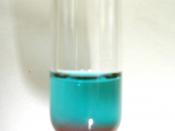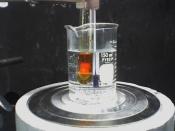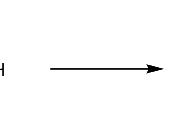Laboratory #6
Qualitative Tests for Carbonyls: Aldehydes vs. Ketones
Introduction
Various chemical tests identifying ketones and aldehydes are used in this experiment in order to identify an unknown carbonyl compound. The tests used are: 2,4-dinitrophenylhydrazone test, Tollen's Test, Benedict's Test, Chromic Acid Test, aka Bordwell-Wellman Test, Schiff's Test, and Iodoform Test. These classification tests provide results based on color change or formation of precipitation, which is then used to determine the identity of the functional group.
The first test, the 2,4-dinitrophenylhydrazone test, determines the presence of a carbon-oxygen double bond. Brady's reagent, another name for the test, is a solution of 2,4-dinitrophenylhydrazine, methanol, and sulfuric acid. When performing the test, a bright orange or yellow precipitate shows the presence of an aldehyde or ketone. This test proceeds via a nucleophilic addition-elimination reaction, as shown below.1
The Tollen's test is used to distinguish between aldehydes and ketones. The reaction works due to the fact that unlike ketones, aldehydes can be readily oxidized.
The Tollen's test is also known as the silver-mirror test, because when the test is positive for aldehydes, a silver mirror forms on the side of the test tube. A sample reaction is shown below.
The Benedict's Test and Chromic Acid Test both work in similar fashion as the Tollen's Test. In the Benedict's Test, cupric salts are used as the oxidizing reagent rather than the silver nitrate. An aldehyde is identified by a brick-red precipitate, while ketones have no reaction.
The Chromic Acid Tests, sometimes known as the Bordwell-Wellman Test, uses chromic acid to oxidize the aldehydes to carboxylic acids. Ketones do not react. When oxidized, the color changes from orange to blue-green.
The Schiff's Test is a chemical test for the detection of aldehydes. When the sample is added to the decolorized Schiff reagent in...


